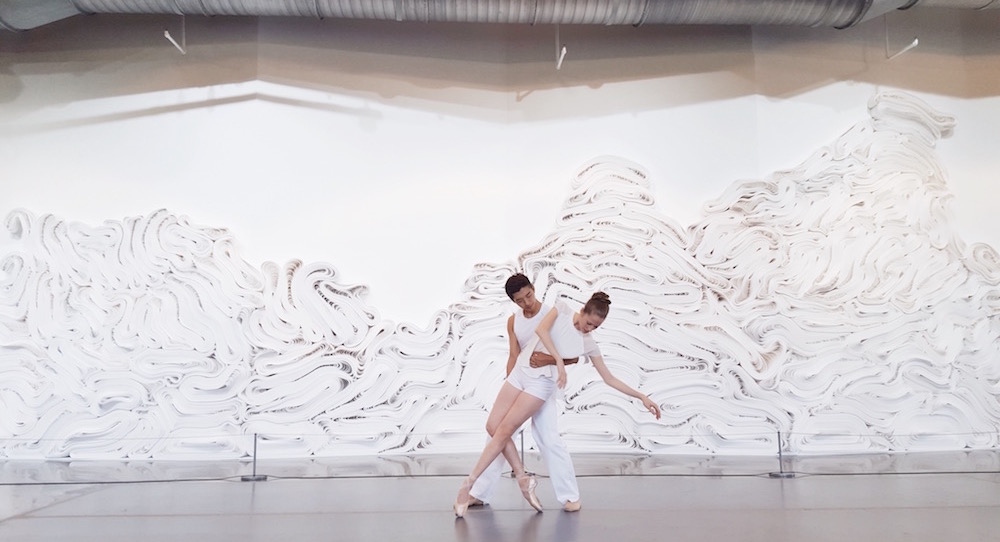A dance performance – beautiful movers grace the space, comfortably moving together where they are and with nothing constraining them. It’s always that simple, right? Not quite. Younger companies, in particular, often don’t yet have the resources to rent out traditional large proscenium stage spaces. They might be in very small stage spaces…or in a corporate building’s ballroom without ideal flooring.
Both might very well (especially the second) not have wings or another space where dancers can “quick-change” or fold over to catch up with breath. There may or may not be a fully equipped sound system and lighting board. That might be more or less important according to the dance form and/or work to be performed. The dancers may or may not have a chance to do a run-through in the space, before dress rehearsal – if even that is possible.
Dance Informa spoke with three choreographers who’ve done their best to “make do” with these types of challenging spaces, and come out with a fairly successful performance on the other end. The general sense that they offered to be the best strategy is to know what you need for a smooth performance to happen, think creatively about how to make it happen, and seek clarity about any and all available resources that might help along the way. Here’s what they have to say.
Kelley Donovan, Kelley Donovan and Dancers and Third Life Choreographer Series (New York, NY, and Boston, MA)
“As early in the choreographic process as you can get into the space, the better. For example, the Third Life space is small, with no risers, so we learned that if you’re going to go to the floor, do it upstage. Otherwise, most people in the audience can’t see that movement very well. I let people joining the series know these kind of things in an initial organizing email.
Also, look out for ways to have more time in the space before performing. Boston Dance Alliance used to have a grant to supply for one-hour rehearsals, apart from dress or tech rehearsal in performances, for example. But dancers are so adaptable. We learn to adapt on the spot, and audiences are none the wiser. This new generation of dancemakers sees space [for performance] and just goes for it!”
Taylor Maurand, Dil Punjabi and Boston Bhangra (Boston, MA)
“On one performance occasion, I didn’t know what the space was going to be, not having had a chance to get in there beforehand. I was clear with the event organizers about what my dancers and I needed, but, despite that, we were locked out and even sent to another building. We didn’t even have time to do a dry run of the set. We were rushed when costuming and settling into the space. When it’s more ideal than that, I picture the space as I’m choreographing. I think about safety aspects as well. What’s the floor like; is there a risk of dancers slipping?
Ask about the sound system, and do a soundcheck if possible. Full, immersive music is crucial to a Bhangra performance, but that might not be the case with all dance forms. When it comes to being close to audience members, encourage dancers to let the joy of performance show through them, and audience members – close or far away – will be drawn in. In general, when it comes to creativity, having a constraint – like a less-than-ideal performance space – can actually be beneficial. If there are boundless possibilities, it can be really hard to know where to begin!”
Sheena Annalise, Arch Contemporary Ballet (New York, NY)
“We sometimes think of performances as being in these big, grand spaces, but that’s not attainable for many younger companies. And some companies aren’t maximizing the space that they do have. That often starts in the studio.Think about making a piece versatile; it may be in a small space now but could be in a bigger space at a later point.
Spaces will be more or less ‘high tech’, with or without a lighting grid. Some spaces don’t look like theaters, such as a performance that we did at a laser instillation. Try to get out of a strictly ‘theater’ mindset; don’t limit a space in your mind, but think of working with it as an expansive opportunity. I look at a space and think about spacing, levels and flooring. Try to find the solutions to problems, rather than focusing on them as problems.
It also helps to be prepared by having everything you think you might need for the performance and the space. Even if you don’t end up using it, many supply stores will take those things back with proof of purchase. B+H and Home Depot are two great stores to get various supplies. With this approach, I’ve never had a problem needing what I need for any space. If everything is settled and prepared, your dancers will be more relaxed and focused on performance.
Also be proud of your space; claim it as your own. For instance, in some places, you’ll need to bring your own signs identifying the performance to audience members and potential audience members. On the plus side, in smaller spaces, there can be more emotional connection between audience members and performers. They tend to be more forgiving because the emotional content pulls them in. Performing in these spaces can also push younger dancers to grow; they really have to pull from inside of themselves.”
By Kathryn Boland of Dance Informa.















